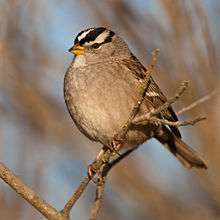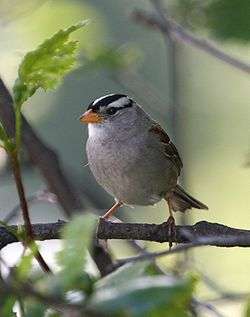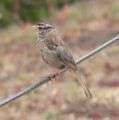White-crowned sparrow
| White-crowned sparrow | |
|---|---|
 | |
| Scientific classification | |
| Kingdom: | Animalia |
| Phylum: | Chordata |
| Class: | Aves |
| Order: | Passeriformes |
| Family: | Emberizidae |
| Genus: | Zonotrichia |
| Species: | Z. leucophrys |
| Binomial name | |
| Zonotrichia leucophrys (Forster, 1772) | |
The white-crowned sparrow (Zonotrichia leucophrys) is a medium-sized sparrow native to North America.
Etymology
The scientific name is from Ancient Greek. The genus Zonotrichia is from zone, "band", and thrix, trikhos, "hair, and the specific leucophrys is from leukos, "white", and ophrus, "eyebrow".[2]
Description
Adults are 18 cm (7 in) long and have black and white stripes on their head, a gray face, brown streaked upper parts and a long tail. The wings are brown with bars and the underparts are gray. Their bill is pink or yellow. They are similar in appearance to the white-throated sparrow, but do not have the white throat markings or yellow lores.
Subspecies

There are five currently recognized subspecies of white-crowned sparrow (pugetensis, gambelii, nuttalli, oriantha, and leucophrys), varying in breeding distribution migratory route. Birds of the subspecies nutalli are permanent residents in California, while birds of the subspecies gambelli may migrate as far as the Arctic Circle during the summer breeding season. Northern birds migrate to the southern United States.
Distribution
Their breeding habitat is brushy areas across northern Canada and the western United States.
The white-crowned sparrow is a very rare vagrant to western Europe.[3] It has been sighted in England, Scotland,[3][4] Ireland,[5] and Norway.[6]
In 2008 a white-crowned sparrow was spotted in Cley next the Sea in Norfolk, England.[7] To commemorate the event an image of the bird was included in a window at St Margaret's Church.
Behavior
These birds forage on the ground or in low vegetation, but sometimes make short flights to catch flying insects. They mainly eat seeds, other plant parts and insects. In winter, they often forage in flocks.
White-crowned sparrows nest either low in bushes or on the ground under shrubs and lay three to five brown-marked gray or greenish-blue eggs.
The white-crowned sparrow is known for its natural alertness mechanism, which allows it to stay awake for up to two weeks during migration.[8] This effect has been studied for possible human applications, such as shift-work drowsiness or truck driving.[9][10][11]
Images
_Morro_Bay%2C_CA_29j_(2232004154).jpg)
 Adult white-crowned sparrow
Adult white-crowned sparrow- The juvenile (first winter) plumage is more muted than the adult
 nuttalli subspecies specimen from Point Lobos State Reserve, California
nuttalli subspecies specimen from Point Lobos State Reserve, California
_at_Owl_Canyon%2C_Bodega_Bay.jpg) Juvenile white-crowned sparrow hunting for food on the ground. Owl Canyon on the western shore of Bodega Harbor, California
Juvenile white-crowned sparrow hunting for food on the ground. Owl Canyon on the western shore of Bodega Harbor, California
See also
References
- ↑ BirdLife International (2012). "Zonotrichia leucophrys". IUCN Red List of Threatened Species. Version 2013.2. International Union for Conservation of Nature. Retrieved 26 November 2013.
- ↑ Jobling, James A. (2010). The Helm Dictionary of Scientific Bird Names. London, United Kingdom: Christopher Helm. pp. 224, 414. ISBN 978-1-4081-2501-4.
- 1 2 Broad, R. A.; Hawley, R. G. (1980). "White-crowned Sparrows: new to Britain and Ireland". British Birds. 73 (10): 466–470.
- ↑ "Rare bird found in coastal garden". BBC News. 9 January 2008. Retrieved 12 August 2011.
- ↑ Hussey, Harry (2003). "The White-crowned Sparrow in County Cork". Birding World. 16 (5): 203–5.
- ↑ "American mob-sparrow declares war on Norway". Archived from the original on 7 October 2009.
- ↑ Unwin, Brian. "White-crowned Sparrow boosts local tourism". The Telegraph. Archived from the original on 28 Aug 2009. Retrieved 28 October 2014.
- ↑ "It's Wake-Up Time". Wired Website. 1 November 2003. Retrieved 28 July 2010.
- ↑ "Migratory Sleeplessness in the White-Crowned Sparrow (Zonotrichia leucophrys gambelii)". PLoS Biology. 2 (7): E212. 13 July 2004. doi:10.1371/journal.pbio.0020212. PMC 449897
 . PMID 15252455.
. PMID 15252455. - ↑ "Alaska sparrow migration mystery". Far North Science Website. 6 November 2007. Retrieved 28 July 2010.
- ↑ "Circadian and Masking Control of Migratory Restlessness in Gambel's White-Crowned Sparrow (Zonotrichia leucophrys gambelii)". Journal of Biological Rhythms. 1 February 2008. Retrieved 28 July 2010.
Further reading
- Chilton, G., M. C. Baker, C. D. Barrentine, and M. A. Cunningham. 1995. White-crowned Sparrow (Zonotrichia leucophrys). In The Birds of North America, No. 183 (A. Poole and F. Gill, eds.). The Academy of Natural Sciences, Philadelphia, and The American Ornithologists’ Union, Washington, D.C.
- Kroodsma DE, Baker MC, Baptista LF & Petrinovich L. (1985). Vocal "dialects" in Nuttall's white-crowned sparrow. In Johnston, R F [Editor] Current Ornithology 103-133, 1985. Plenum Press, 233 Spring Street, New York, New York.
External links
| Wikimedia Commons has media related to the white-crowned sparrow. |
| Wikispecies has information related to: Zonotrichia leucophrys |
- White-crowned sparrow species account - Cornell Lab of Ornithology
- White-crowned sparrow - Zonotrichia leucophrys - USGS Patuxent Bird Identification InfoCenter
- "White-crowned sparrow media". Internet Bird Collection.
- White-crowned sparrow photo gallery at VIREO (Drexel University)
- Daily Mail article about a white-crowned sparrow as an exotic visitor to the UK, now commemorated in a church window
- Interactive range map of Zonotrichia leucophrys at IUCN Red List maps
